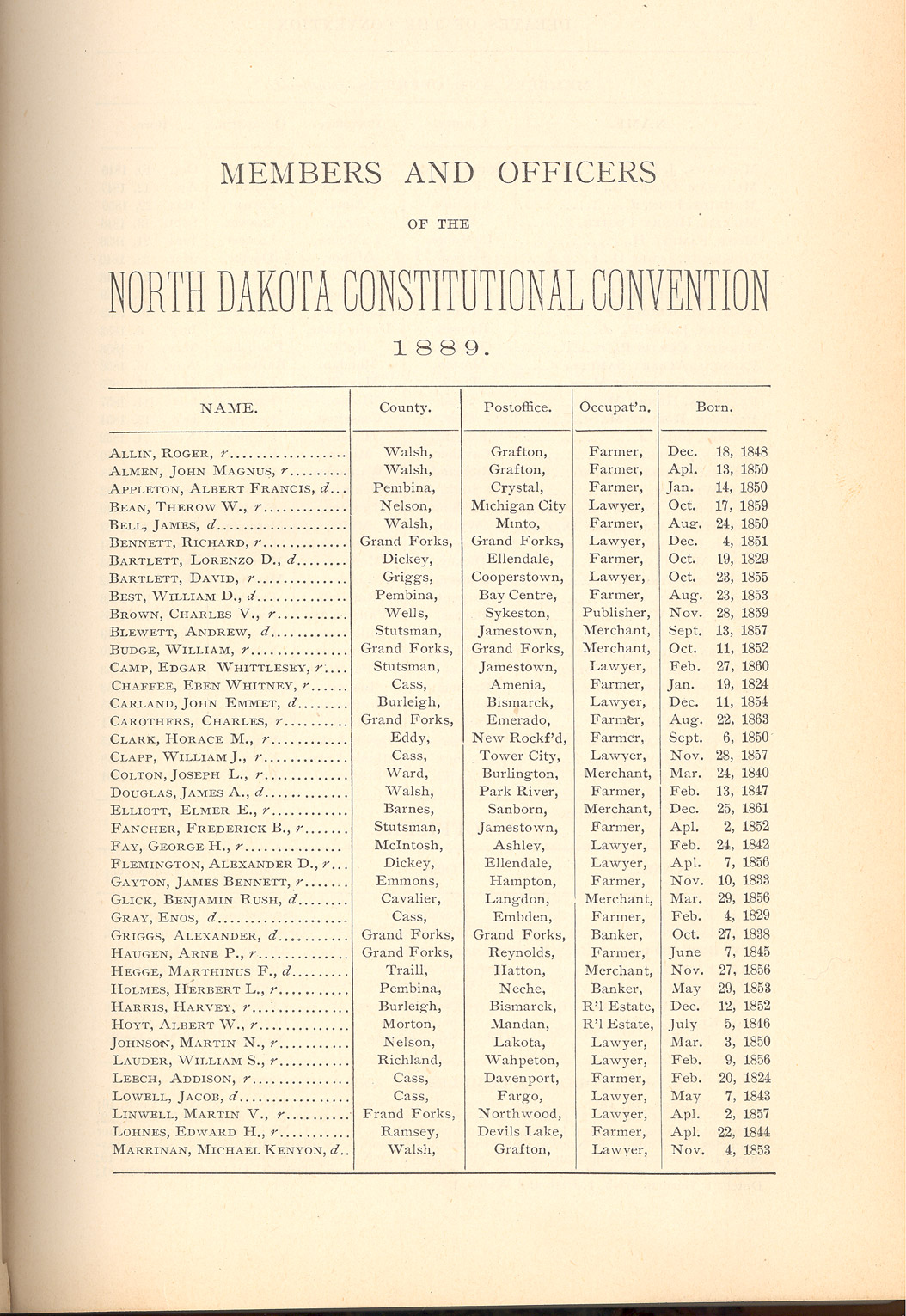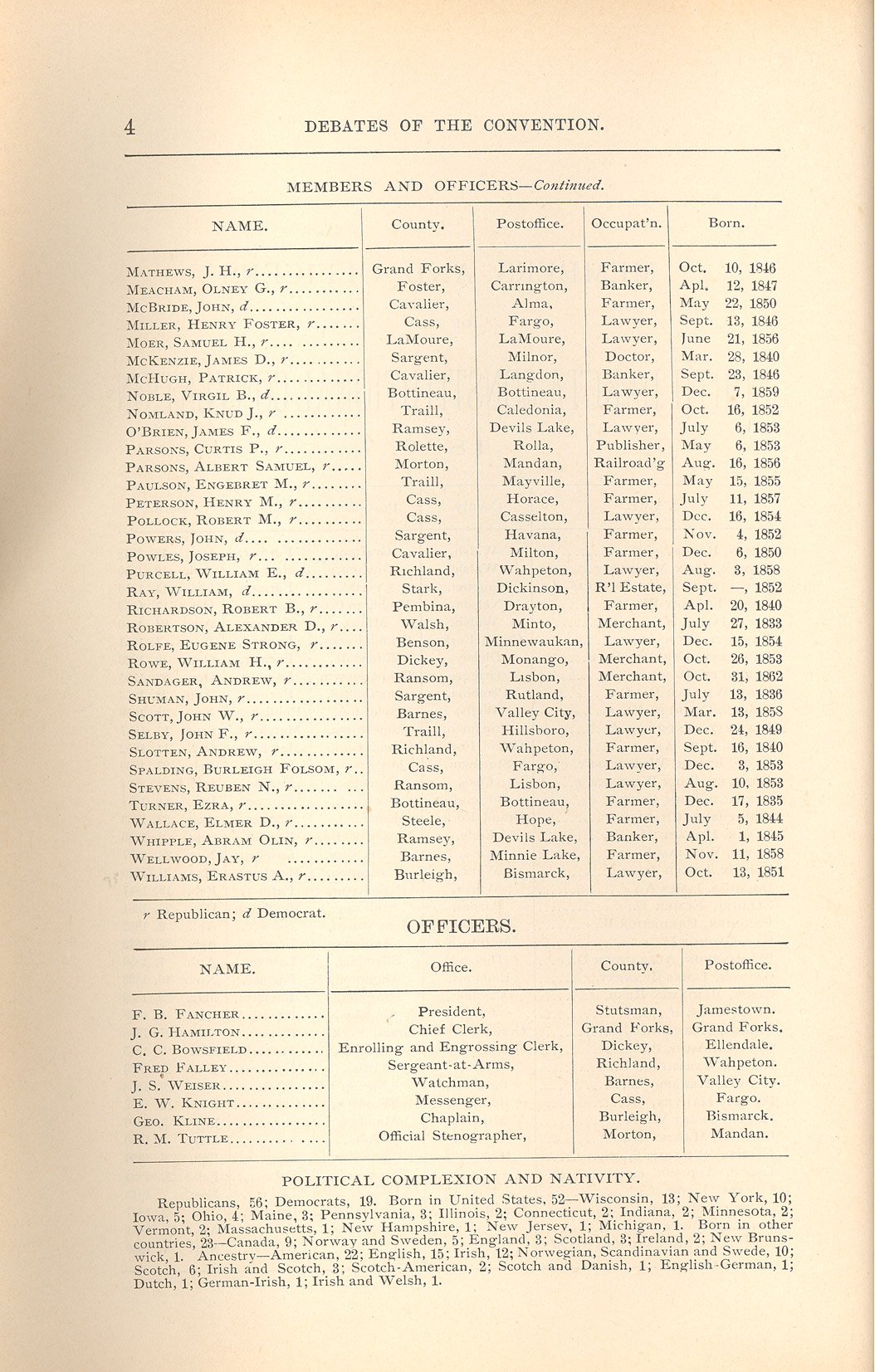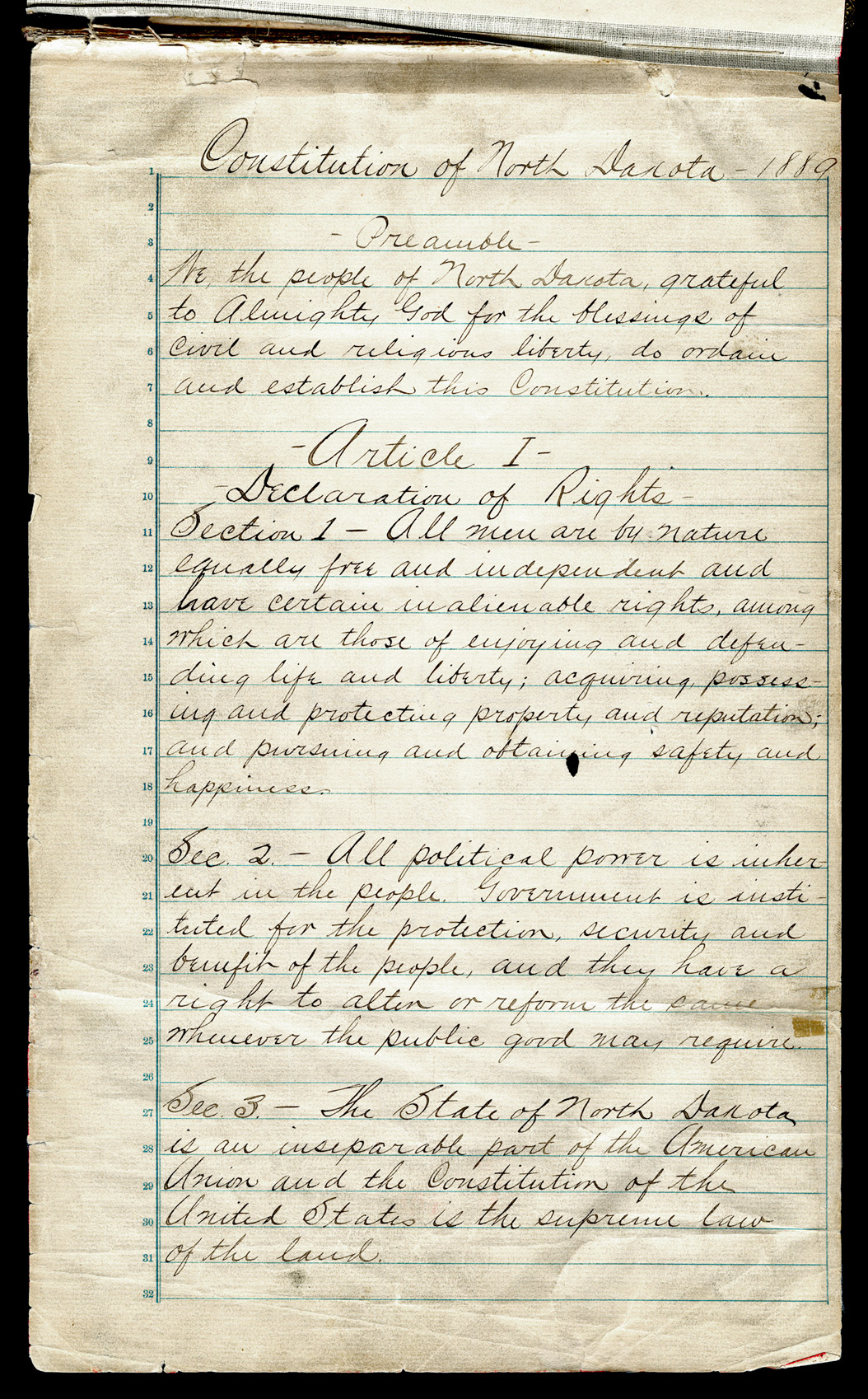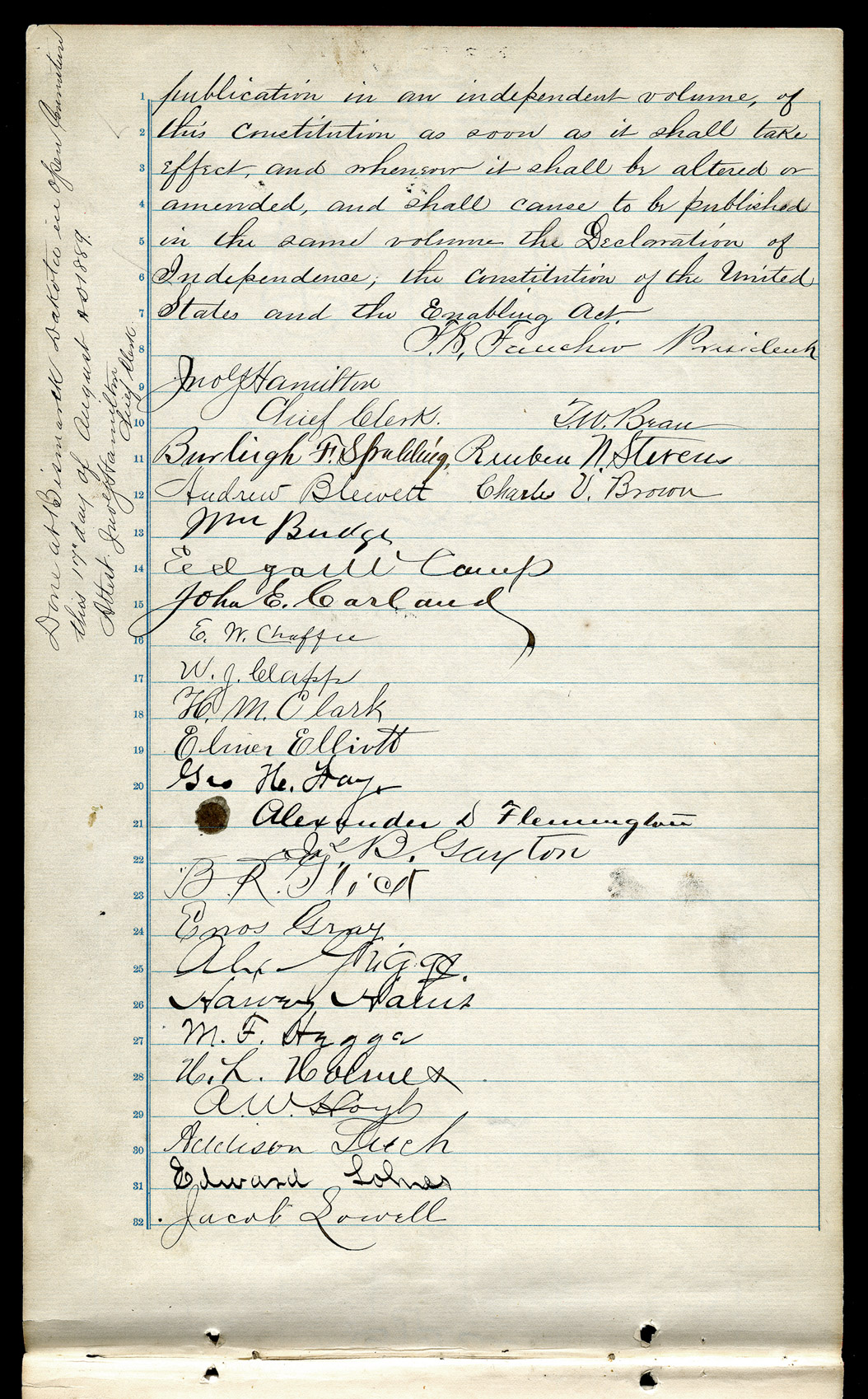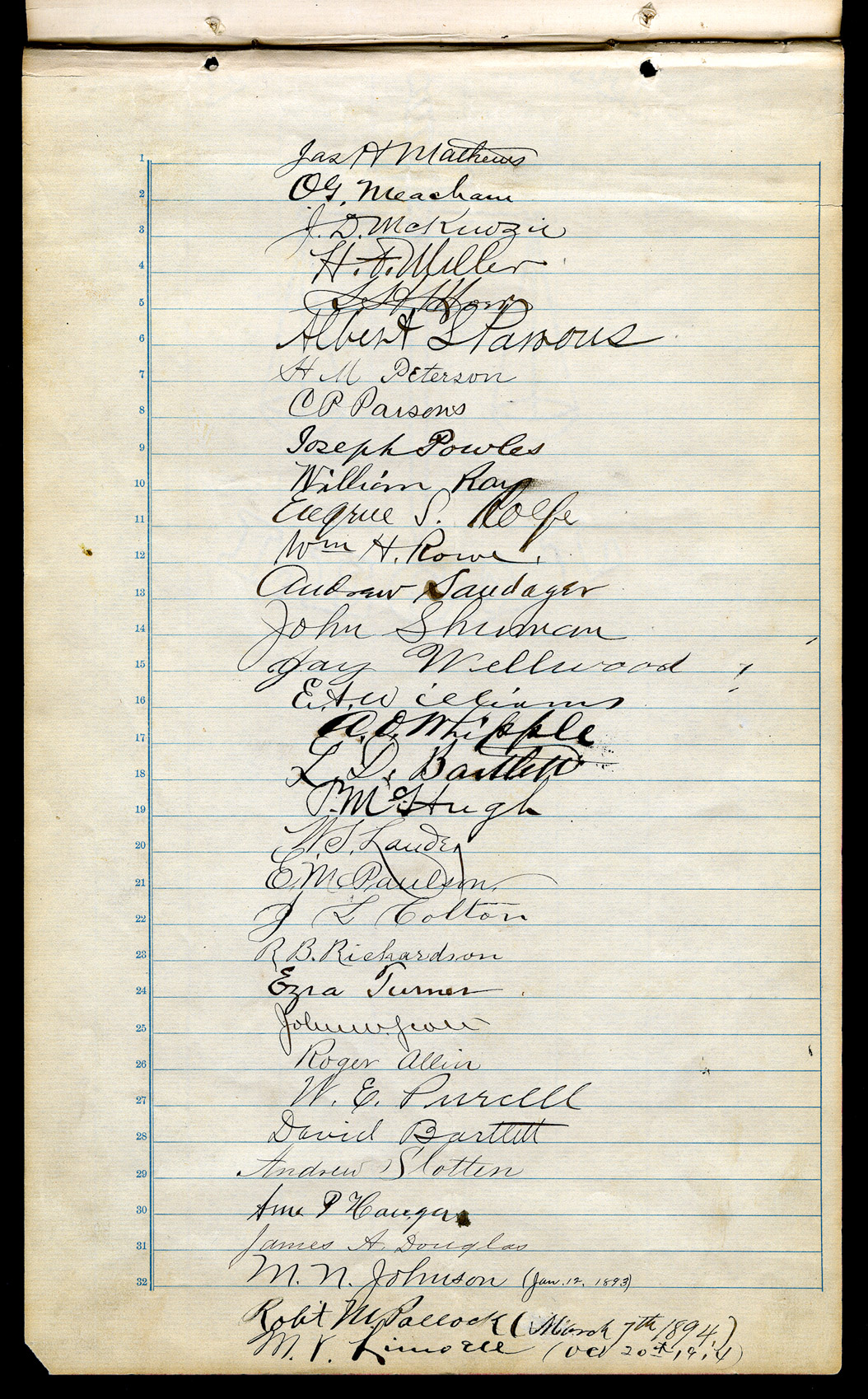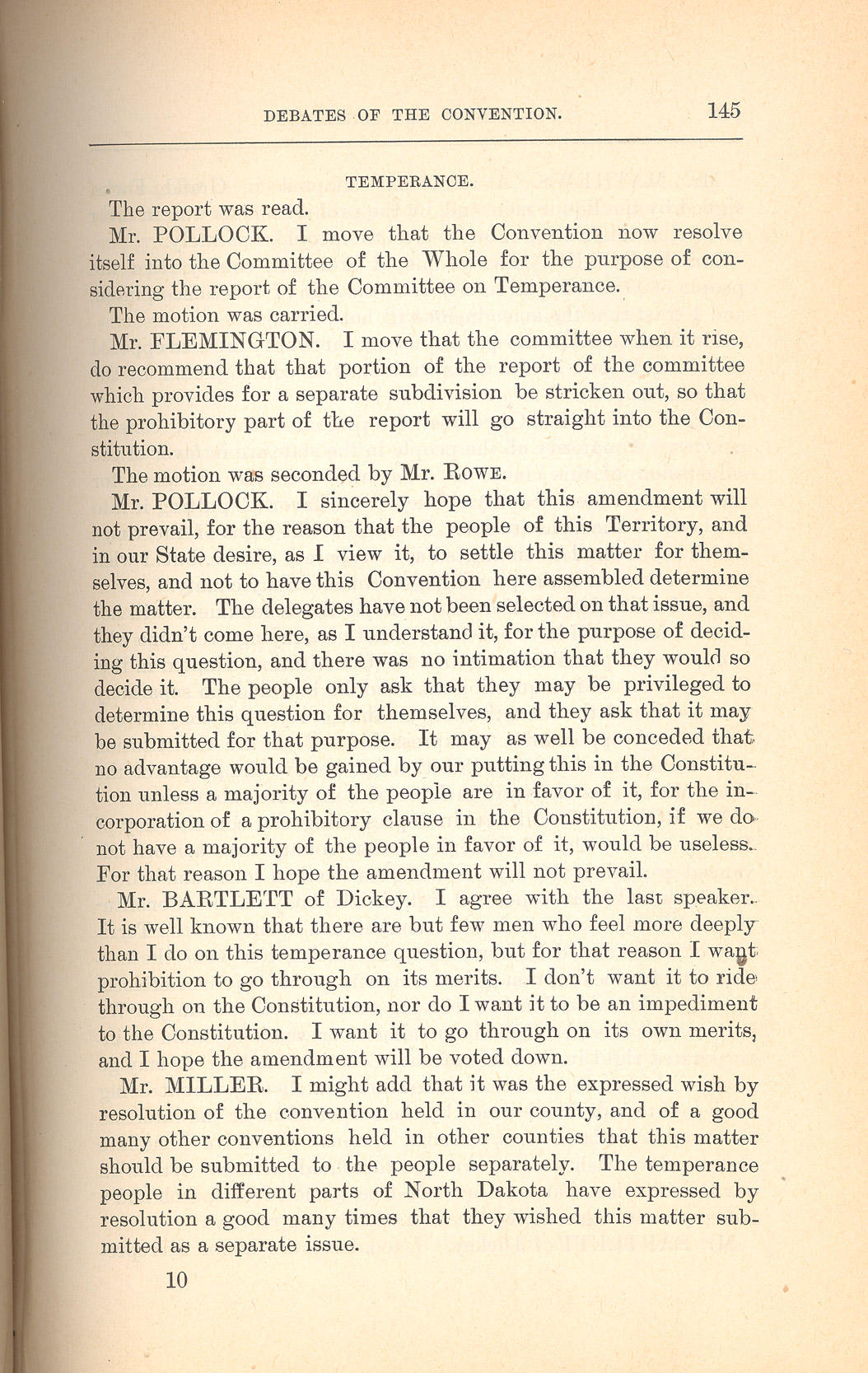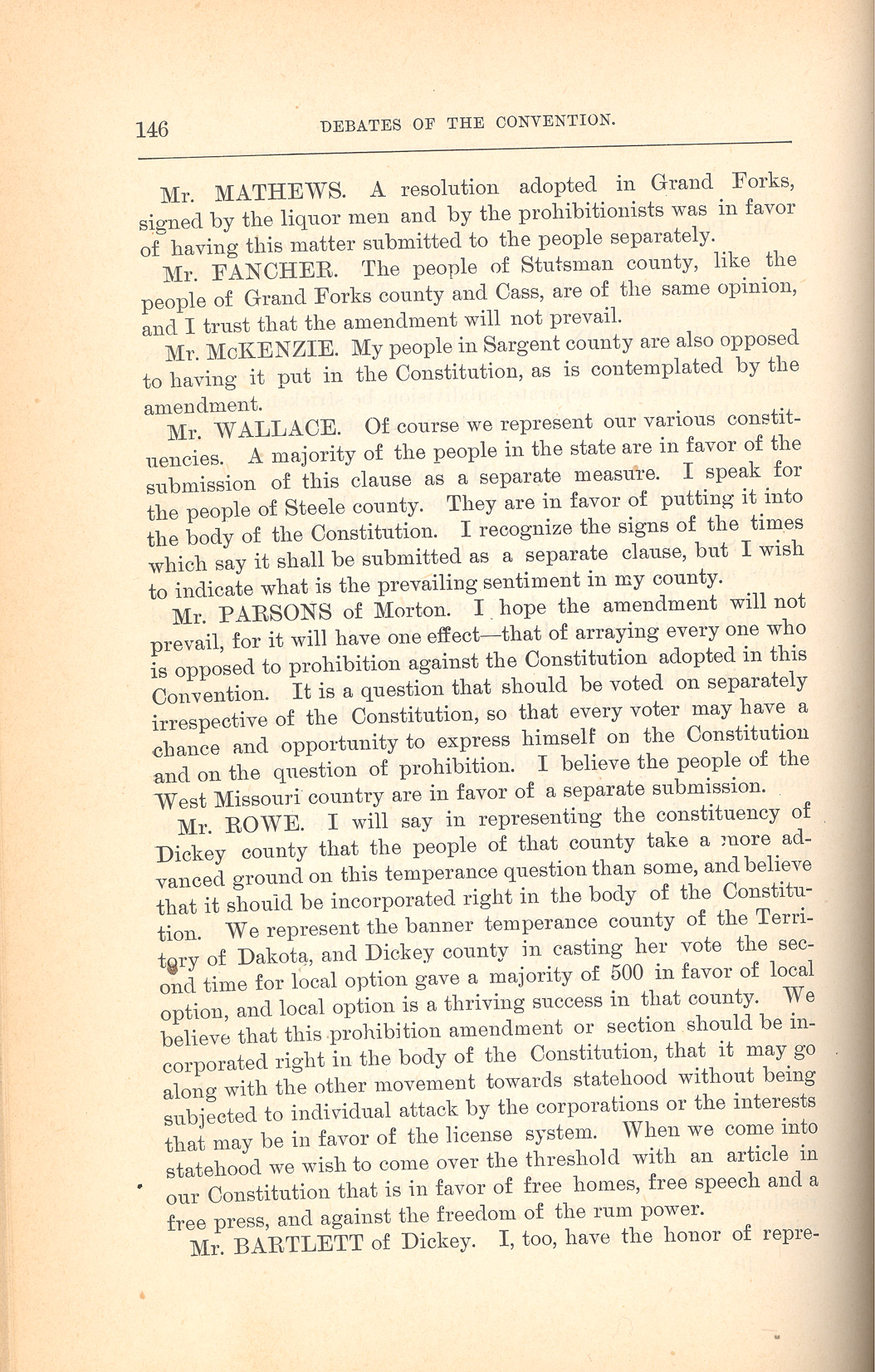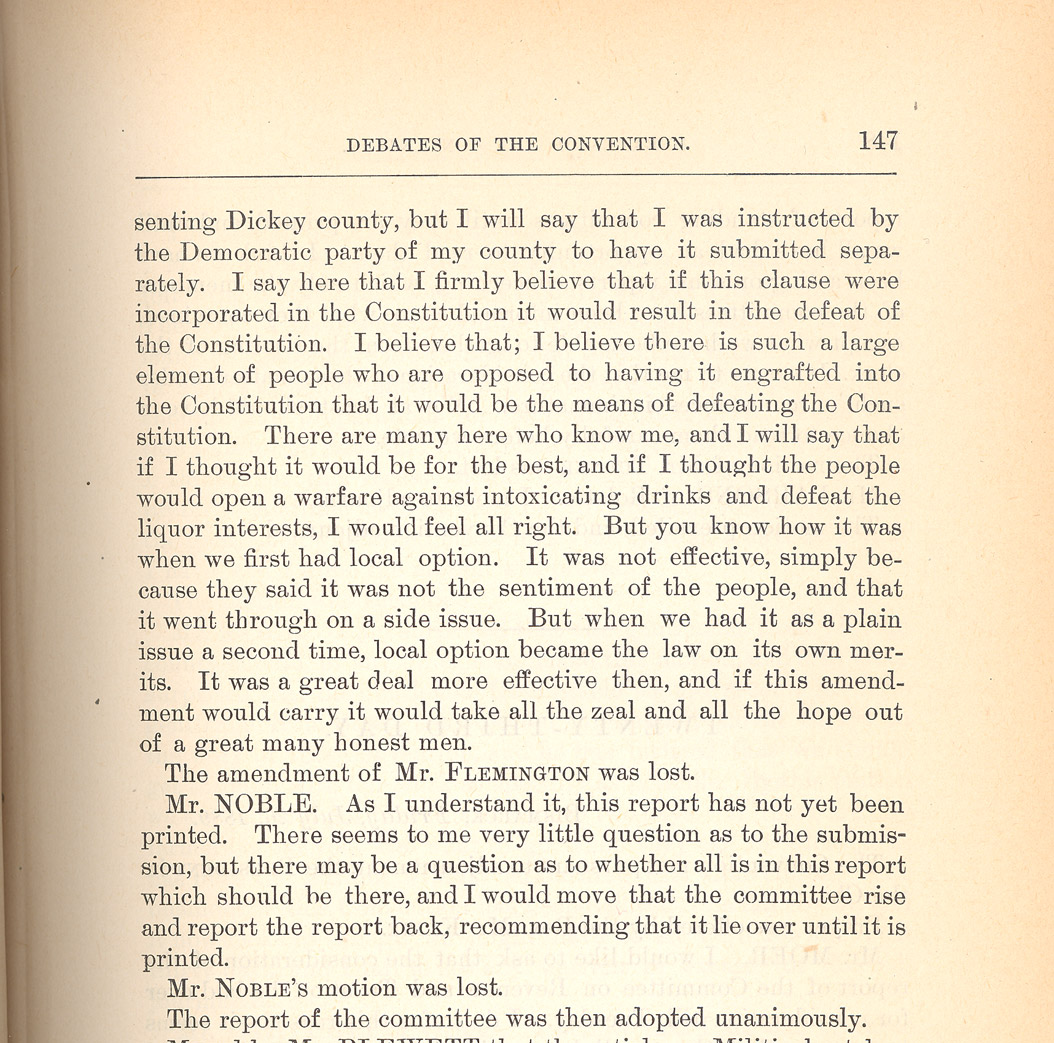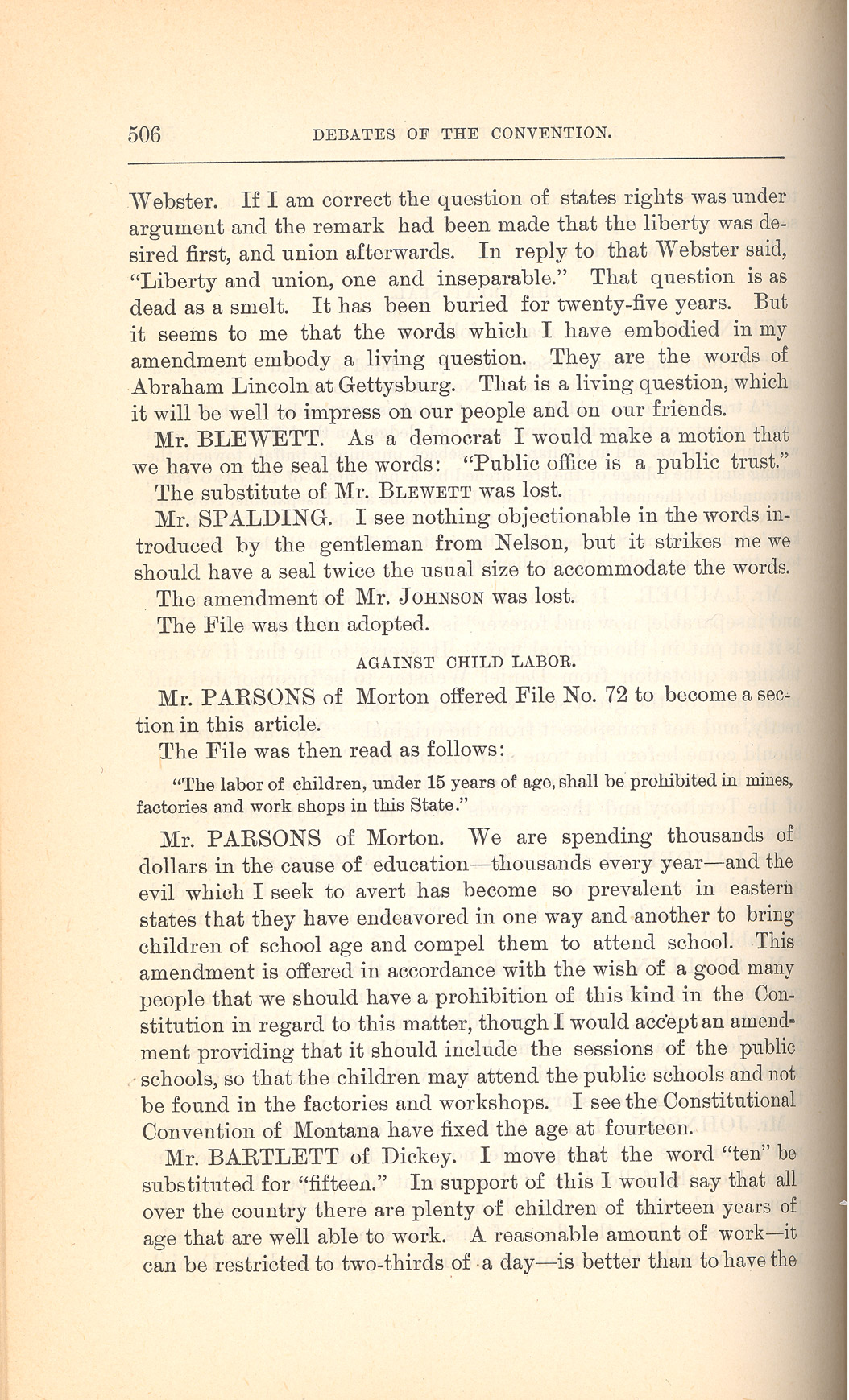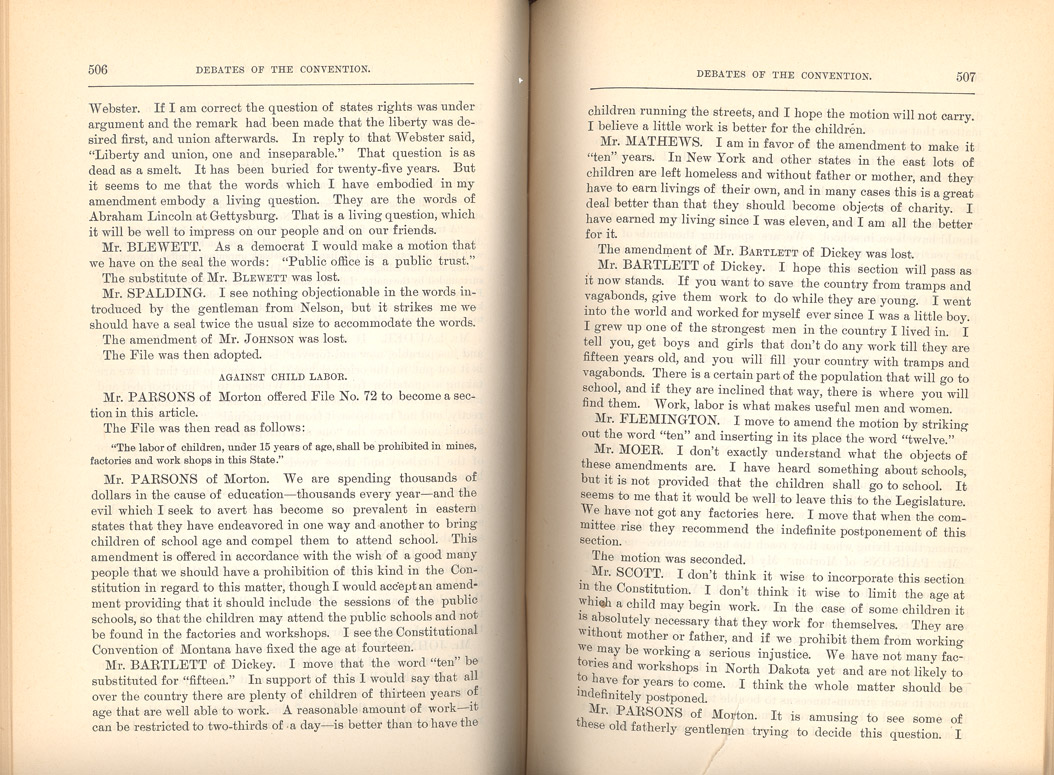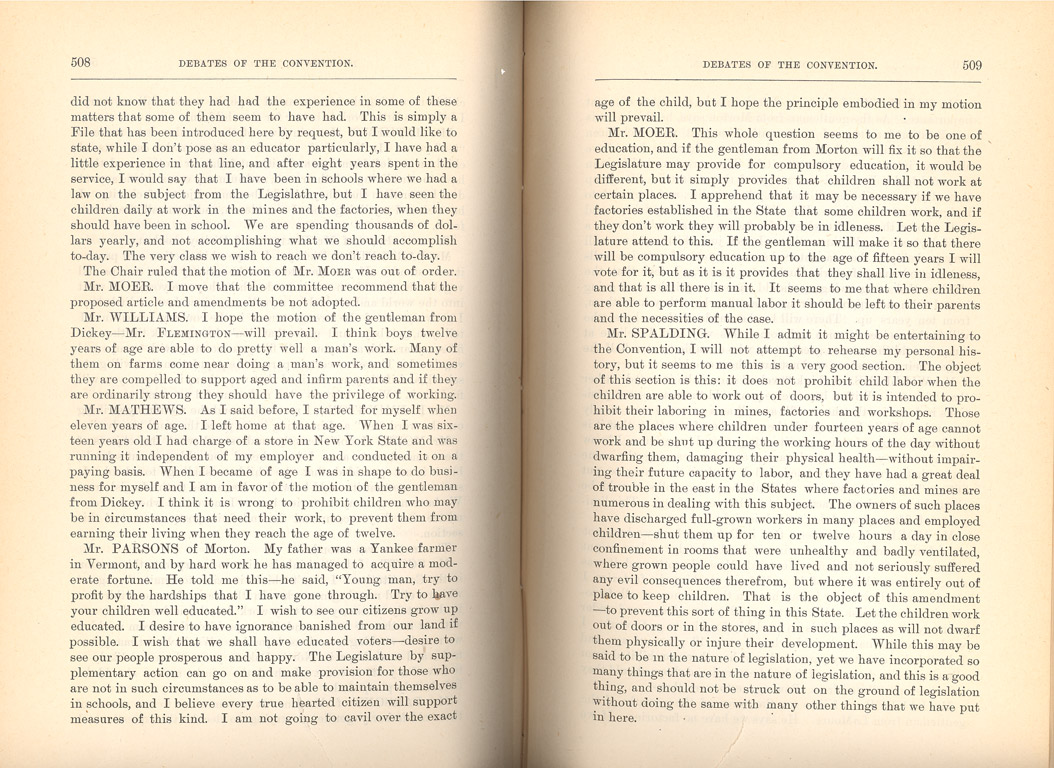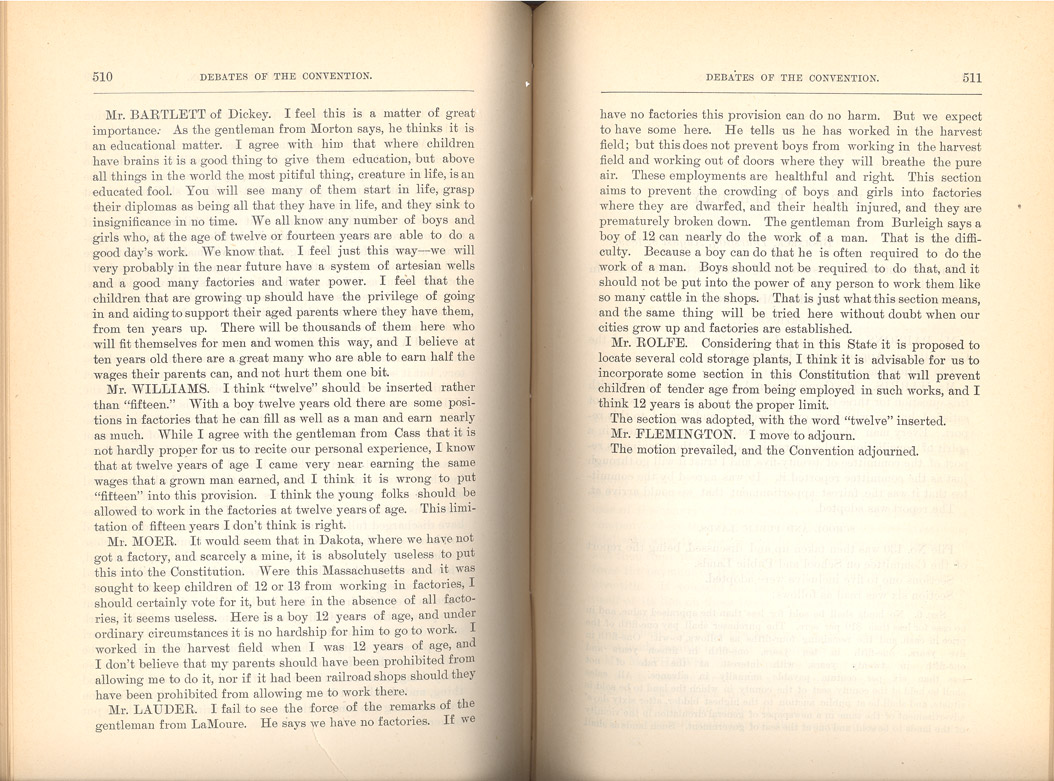Each county chose delegates to attend the constitutional convention. The convention was held in Bismarck and began on the national holiday, July 4, 1889. The city of Bismarck helped to welcome the delegates and celebrated the coming of statehood with a parade. (See Image 1) Part of the parade was celebratory with bands, marching soldiers, and riders on horseback. Another part of the parade was symbolic. Lakotas from Standing Rock Reservation were invited to march in the parade. (See Image 2) They carried two signs. One read “The March of Civilization” indicating that over time, Dakota had become more civilized. The second sign read “Dakota as a Territory” which appears to symbolize the idea that Indians and conflict were left behind with territorial days.


When the delegates met in convention to write a constitution, they were aware of several national debates that would influence their decisions. Child labor, women’s suffrage (the right to vote), and prohibition of the manufacture and sale of alcoholic beverages were debated by reformers, politicians, and corporate leaders all over the country.

The delegates appropriately debated important issues of the day as well as the framework of the constitution. (See Image 3) (See Document 2) They were advised in their duties by several speakers. On Monday, July 8, 1889, Henry B. Blackwell (1825–1909) of Boston addressed the convention. Mr. Blackwell was an ardent advocate of woman suffrage. His lengthy speech was entirely devoted to woman suffrage.

On July 11, the eighth day of the convention, Governor Arthur C. Mellette (1842-1896), the last governor of Dakota Territory, addressed the delegates. (See Image 4) Governor Mellette urged the delegates to debate issues thoroughly, and that “after the discussions are over you will determine what is the proper thing to do upon the questions. . . .” Governor Mellette encouraged the delegates to embody as much legislation in the constitution as they could. He argued that “once embodied therein it is very difficult to get rid of it and effect a change. But if [the issue] is right, the more there is in the constitution the better for the people.”
The most important speaker to address the convention arrived on the 14th day, July 17, 1889. He was Judge Thomas M. Cooley (1824-1898), a highly respected legal scholar, former dean of the Michigan University Law School, former justice of the Michigan Supreme Court, and member of the Interstate Commerce Commission. His message was entirely different from Governor Mellette’s message. In one of the shorter speeches addressing the delegates, Judge Cooley stated: “Don’t in your constitution-making legislate too much. In your Constitution you are tying the hands of the people. Don’t do that to any such extent as to prevent the Legislature hereafter from meeting all evils that may be within the reach of proper legislation. Leave something for them. . . . You have got to trust somebody in the future and it is right and proper that each department of government should be trusted to perform its legitimate function.”
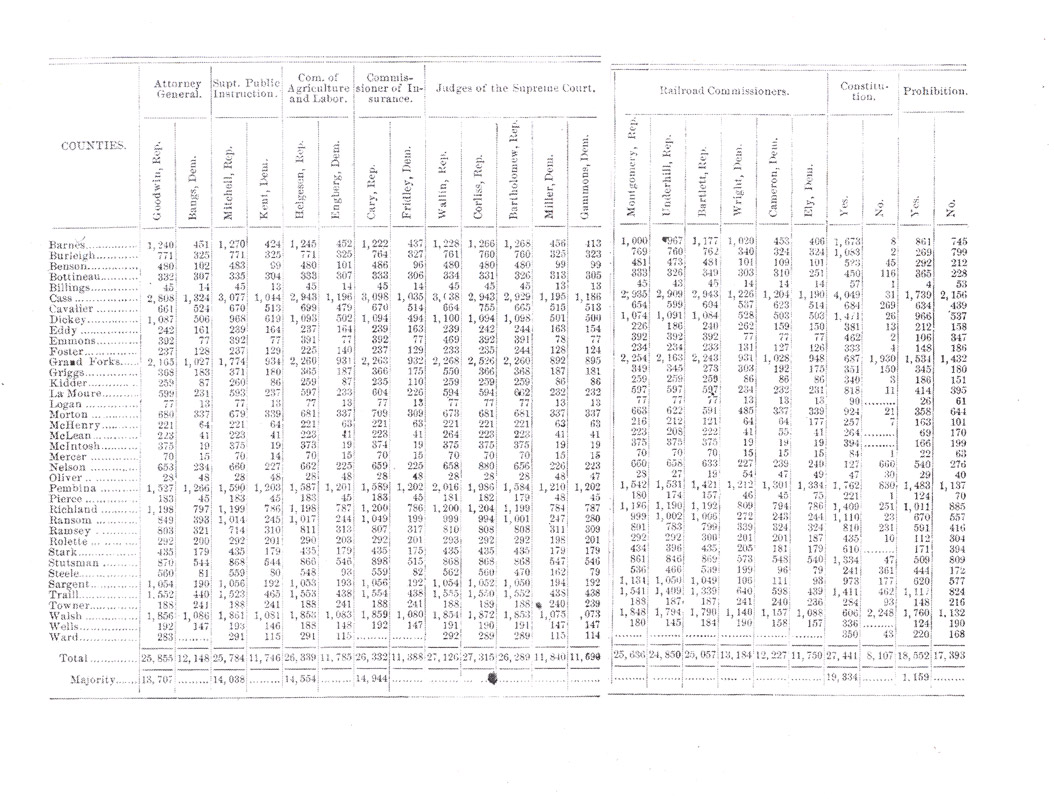
The delegates chosen to represent each organized county began meeting on July 4, 1889 in Bismarck. The convention completed its work on August 17, the 45th day of the meeting. (See Document 3) On October 1, the people of North Dakota voted on the constitution and one separate clause concerning prohibition. The constitution was approved by the voters, 27,441 to 8,107. The prohibition clause was also approved by the voters, but it was by a smaller margin: 18,552 to 17,393. (See Document 4) North Dakota’s first constitution remains in effect today though it has been greatly changed over the years.
Why is this important?The delegates had a great burden. They had to create a constitution that would serve the people of North Dakota. They had to make decisions that were not only correct, but reflected the will of the people. The delegates brought their own ideas and interests into the debates, but they also had to be willing to change their ideas a little bit as the debates proceeded. The delegates also had to respect the ideas of the people who elected them.
The finished constitution had to be submitted to the people for a vote by October 1. If the people voted against accepting the constitution, North Dakota would remain a territory. The people, in all but four counties, voted to accept the constitution. The counties that voted against the constitution were Grand Forks, Nelson, Steele, and Walsh. The counties that voted against the prohibition clause included: Billings, Burleigh, Cass, Emmons, Foster, Logan, Morton, McIntosh, McLean, Mercer, Oliver, Rolette, Stark, Stutsman, Towner, and Wells. North Dakota entered the Union on November 2, 1889 as a “dry” (prohibition) state.
Sources: Bismarck Weekly Tribune, October 11, 1889. (http://chroniclingamerica.loc.gov/)
Official Report of the Proceedings and Debates of the First Constitutional Convention of North Dakota. R. M. Tuttle, Official Stenographer. Bismarck, 1889.
North Dakota Constitution www.legis.nd.gov/constitution
Convention Debates: Prohibition
A committee brought the question of prohibitionProhibition refers to government action to prohibit the manufacture and sale of alcoholic beverages. Another word for prohibition is temperance. Temperance, however, is a little different. Temperance usually refers to a personal philosophy. A person who believes in temperance would try to avoid drinking alcoholic beverages. During the 19th century many people “took the pledge” to stop drinking. The question was divided by gender. It was most often men who pledged temperance, but the political force behind temperance and prohibition was usually guided by women working through organizations such as the Woman’s Christian Temperance Union.of the manufacture, sale, and distribution of alcoholic beverages to the delegates with one issue for debate. That issue was whether the prohibition clause should be part of the constitution when the people voted on the constitution, or whether the prohibition clause should be submitted to the people for a separate vote. The debates on pages 145 through 147 reveal the delegates struggling with their personal views and the views of the people who elected them to the convention. (See Document 5)
In summary, Mr. Flemington moved to have prohibition in the constitution, but not submitted to the people for a separate vote. Mr. Pollock said the people want to vote on the question themselves. Some delegates felt they had a mandate from the voters who elected them to put the issue into the constitution. Other delegates noted that many voters, including the “liquor men” of Grand Forks, wanted the clause to go to the people separately.
Mr. Flemington’s motion failed, and the prohibition clause of the constitution went to the voters for a vote separate from the constitution. The prohibition clause stated:
Prohibition
§217. No person, association or corporation shall within this State, manufacture for sale or gift, any intoxicating liquors and no person, association or corporation shall import any of the same for sale or gift, or keep or sell or offer the same for sale, or gift, barter or trade as a beverage. The Legislative Assembly shall by law prescribe regulations for the enforcement of the provisions of this article and shall thereby provide suitable penalties for the violation thereof.


Prohibition was approved by the voters by a narrow margin. Many voters were surprised. (See Document 6) The owners of breweries had to lock up their buildings and did not receive compensation for their lost business. (See Document 7)


The state passed enforcement laws and much of the state went “dry” on July 1, 1890. However, in the border cities of Fargo and Grand Forks, people who wanted to drink or to buy liquor to take home drove to liquor stores in Moorhead or East Grand Forks, Minnesota. In western North Dakota, "blind pigs"The term blind pig was commonly used during prohibition to refer to a “speak-easy” or any establishment that sold illegal liquor. As the term was originally used, bar owners charged for admission to a special exhibit such as a pig. Once inside, the customers received a complimentary drink. In North Dakota, the term was widely used for illegal bars, but it is doubtful that these bars had special exhibits. sold liquor. (See Image 5) A blind pig was a place that sold liquor illegally. Few sheriffs in western counties paid attention to blind pigs. (See Image 6)
Source: Bismarck Tribune October 11, 1889.
Convention Debates: Woman Suffrage
On the question of women’s right to vote (suffrage), debates concerned the role of the Constitution in providing for the extension of woman suffrage beyond school suffrage. Women of Dakota Territory had voted on all school issues and had been elected to school boards and to the position of County Superintendent of Schools since 1883. (See Image 7) In 1889, the constitutional convention debated woman suffrage and whether it was appropriate for the constitution or the legislature to extend women’s right to vote to other offices. Several delegates suggested that the extension of woman suffrage beyond school issues should be left to the popular vote. The debate was raised on several different days. These excerpts reflect the ideas of the very lengthy debates.

On July 31, 1889, John Carland of Bismarck made the following statement (pg. 200):
“I don’t wish to discuss the question of woman suffrage here. I would, however, make one reference to the matter, and I hope you will pardon me for it. I have been so fortunate in life as to be a married man, and so fortunate as to have these relations pleasant and agreeable. I have the honor of having the presence of my wife here to-day and I have too much deference to the institution [marriage] which I believe was established by God Himself and above a civil contract – too much deference to that institution, to ever favor the proposition of woman suffrage and she is with me in this position. So far we will let that subject drop and proceed to the question before us. Shall it be left to the Legislature or the people? I am an American. The question seems to be, and always has been granted, that the sovereignty of this government rests in the hands of the people, therefore I am opposed to ever leaving [to] the Legislature the unqualified power of extending the right of suffrage.”
On the same day, William Lauder (Wahpeton, Richland) stated (pg. 203):
“I am in favor of having this question submitted to a vote of the people. If they want the franchise [right to vote] extended to women, let it be so extended. I would let the women vote on this question as well as the men. Let the women themselves say on this final vote when the question is submitted whether the suffrage shall be extended.”
On August 1, 1889, the delegates took up the question of suffrage again. Mr. Moer of LaMoure moved (pg. 276):
“The Legislature shall be empowered to make further extensions of suffrage hereafter at its discretion to all citizens of mature age and sound mind, not convicted of crime, without regard to sex, but shall not extend nor restrict the right of suffrage without first submitting the question to the voters to be by them ratified by a majority vote.”
Mr. Spalding of Fargo, offered an amendment to Mr. Moer’s motion (pg. 281):
“The Legislature shall be empowered to make extensions of suffrage to females of mature age and sound mind, not convicted of crime, and if such extension is made, may at any time thereafter restrict the same.”
Mr. Spalding’s amendment was not approved.
Mr. Turner of Bottineau offered another amendment (pg. 282):
“The Legislature shall be empowered to make further extension of the suffrage hereafter at its discretion to all citizens of mature age and sound mind, not convicted of crime, without regard to sex, but not to hold office, but as otherwise provided for in this Constitution, without being submitted to a vote of the people.”
Mr. Turner’s motion was not approved. Mr. Moer’s motion was adopted.
The delegates to the Constitution Convention ultimately decided against submitting a clause on extended woman suffrage to the people with the constitution. However, the North Dakota Constitution included the following clause:
§Section 8: Any woman having the qualifications enumerated in section one of this article as to age, residence and citizenship, and including those now qualified by the laws of the Territory, may vote at any election held solely for school purposes.
Convention Debates: Child Labor
On August 7, 1889, the 35th day of the constitutional convention, the delegates considered the question of child labor. As manufacturing increased in the United States, this debate was taking place in cities and states all over the nation. Many very young children worked deep underground in coal mines. Children as young as four years of age performed simple tasks in clothing factories for several hours a day.
In Bismarck, as the delegates discussed child labor, two issues arose. (See Document 8) The first was at what age children should be allowed to work in mines or factories. The original wording of this section of the constitution set the age at 15. The second question was whether it was appropriate for the issue to be part of the constitution or whether it should remain a legislative issue.
The delegates voted favorably to include the proposed section 209 of Article XVII in the constitution. The section read:
§209. The labor of children under twelve years of age shall be prohibited in mines, factories and workshops in this State.



